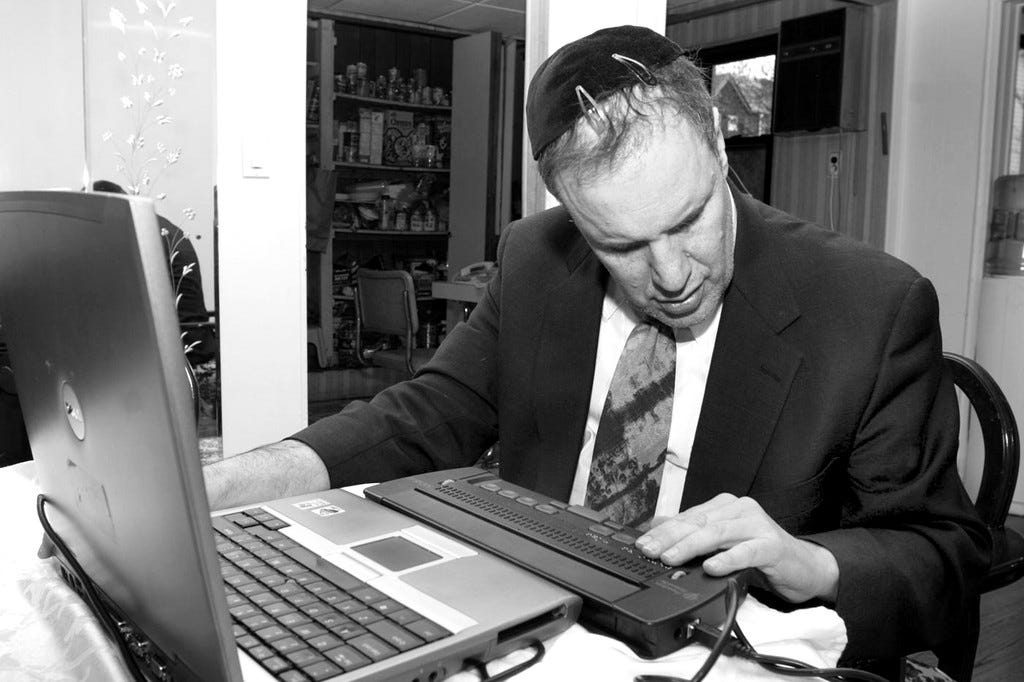The following essay is dedicated in honored memory to Mr. Emanuel Aryeh. He enclosed the entire world in the embrace of his family.
Passover resembles a valuable stock option: the more you invest in it, the more it “gives back.” The investment starts immediately after Purim.
The P.E.A.R.L. system is a guide to integrating people with disabilities into the Passover preparation experience.
P: Participation
No matter what your intellectual ability and communications skill, you can be part of the adventure of putting away the chometz, leaven-laden year-round dishes and replacing them with those precious Passover dishes that sometimes are bequeathed from one generation to the next. During my student days at JTS, my blindness was an asset in the nearby Levinsohn household. Standing atop a ladder, I reached wayyy back on the top shelf of a closet where no light ever shined. I handed down the precious dishes to Tres. After two hours, she sent me back to my dorm room with a snack. After Passover, she handed me up those dishes to where they would hibernate until next Passover and sent me back with another snack.
E: Emancipation
Sometimes the Seder is so jam-packed with activity that there is little time to discuss it in depth. Over weekday and Shabbat meals, explain that we all are “slaves” to inner fears of failure, wounds from cruel jibes about our disability, and that nagging feeling that nothing will ever change. What would personal emancipation look like for us if we concentrated on one liberating goal this Passover season?
We can link our own stories to our original liberation from slavery. How about learning Passover songs in advance?
My family treasured “One morning when Pharaoh woke up in his bed…” Here’s an interesting version.
There are of course songs straight from the Haggadah itself: Dayenu, Adir Hu, and Chad Gadya.
A: Accommodation
Go beyond Haggadahs in special format and table arrangements for wheelchair users. Arrange for a person of non-typical intelligence to have an important function. It can be SHE who points to the Matzah, Maror and shank bone when Rabban Gamliel tells us that these are the three most important objects adorning the table. HE can sequester the Aphikoman.
R: Rules
Behind the scenes, the Passover story reveals that we transitioned from slavery under cruel taskmasters to becoming obedient servants of the kind and compassionate Almighty. During the Seder, God’s Rules rule. We wait to eat the matzah until just before the meal. WE relive our liberation by raising a cup of wine to symbolize our freedom. We do not continue eating after the Aphikoman.
A seder during which a “special person” with a disability flaunts all rules is a travesty of inclusion. It can give “disability inclusion” a bad name.
If Sandy can’t follow all the rules, let her follow some of them. If Harry becomes disruptive, he may need a few moments of private time until he is ready to return to the seder table.
L: Laughter
Before Birkat Hamazon (the blessings after the meal), we sing Shir Hama-aloat (Psalm 126.) It tells us that when the final redemption occurs, “our mouth will be filled with laughter, and our tongue with joyous song.” During the Ten Plagues, croak like a frog. Dance during Hallel! Can you sing the final and longest stanza of Echad Mi Yodea “Who knows one?” while taking only three breaths?
The “return” on your Passover investment
After the Seder, disabled and non-disabled alike will drift off to sleep much later than usual. All the memories of preparation and participation will transition into pleasant dreams.
During Passover and beyond it, there will be a reality that was not a dream at all:
“I was valued. I participated. I belonged.”
A native of Bradley Beach, New Jersey, Rabbi Michael Levy attributes his achievements to G-d's beneficence and to his courageous parents. They supported him as he learned to travel independently, visited Israel, and became more Jewishly observant. For 65 years, JBI International supported him with braille and recorded Judaica material.
He received rabbinic ordination from the Jewish Theological Seminary in 1981 and an MSW from Columbia University in 1982.
As a board member and now President of Yad Hachazakah, Rabbi Levy strives to make the Jewish experience and Jewish texts accessible to Jews with disabilities. In lectures at synagogues, camps, and educational institutions, he cites Nachshon, who according to tradition boldly took the plunge into the Red Sea even before it miraculously parted. Rabbi Levy elaborates, "We who have disabilities should be Nachshons--boldly taking the plunge into the Jewish experience, supported by laws and lore that mandate our integration.”
He applauds Jewish Disability Inclusion News’s ambition to give voice not just to those who work with the disabled, but also to people with disabilities themselves. “About us? Not without us” he is fond of reminding those eager to listen, and the media to whom the maxim may be out of their comfort zone.
For over 20 years, Rabbi Levy served as director of Travel Training at MTA New York CityTransit. Now retired, he is an active participant in Congregations Aish Kodesh and Young Israel in Woodmere, New York. Most of all, he relishes the company of his children, grandchildren, and large extended family.



